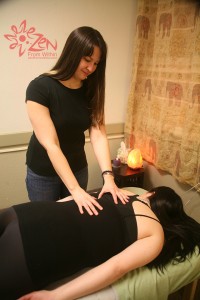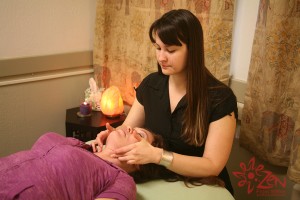How Does Bowen Therapy Work?
People often wonder how such a gentle approach can yield such profound results. Here are some of the mechanisms that help explain the remarkable effectiveness of Bowen Therapy:
The Nervous System:
The entire nervous system functions as a vast communication network. Feedback is constantly exchanged among the body’s parts and the Central Nervous System (CNS), which integrates and coordinates all body systems and activities. The Bowen ‘moves’ add new information to these feedback loops, stimulating the CNS to do a systems check and initiate a healing response.
Studies have shown that Bowen Therapy has a profound affect on the Autonomic Nervous System (ANS). The ANS regulates the stress response and controls over 80% of body functions, including; cardiac, respiratory, peripheral circulation, reproductive, endocrine and gastrointestinal. Most people today live in a constant state of elevated stress, or sympathetic nervous system dominance (fight, flight or freeze mode). When in this state our internal resources are mobilized for survival and unavailable for healing and restoring the body.
Bowen Therapy helps shift the nervous system into parasympathetic dominance (rest, relax and repair mode), sending the message to the body’s systems that the emergency is over. Once this shift occurs, stress symptoms are alleviated and the body can do what it innately does: heal itself.
In relation to soft tissues, the stress response can be activated by injuries, illness, surgery or trauma, causing the surrounding muscles to become locked in a protective contraction. This contraction may be initially helpful, but, if not released, over time it can create imbalances in the myofascial system. When Bowen moves send the signal to the nervous system that the emergency is over, tension levels in the muscles are reset to normal resting length and strain patterns in the fascia are released, allowing a return to optimal functioning. Stress is a fact of life; Bowen Therapy is the perfect antidote.
Nerve Receptors and Proprioceptors:
Nerve receptors and proprioceptors are an important part of the body’s intricate communication network. Most Bowen moves are performed where Golgi and spindle nerve receptors are located. These receptors inform the nervous system of the state of tension, length, or stretch in the muscles and tendons. Bowen moves stimulate the receptors, which changes the information received by the nervous system, helping to reset tension levels and break the pain-spasm-pain cycle.
All moves done around a joint directly affect the ligaments and joint capsule (the connective tissue surrounding a joint), which are richly innervated with proprioceptors. When stimulated, these proprioceptors send messages to the central nervous system, inviting normalization of joint function.
Fascia:
Fascia is a continuous three-dimensional fibrous tissue that surrounds and supports all your muscles, organs, blood vessels, and nerves. It is in a sense, it is the “web” that holds your body together and plays a dynamic role in stabilizing, supporting and cushioning the body from head to toe. It plays an essential role in muscle function, flexibility, postural alignment and structural integrity and affects immune system function. Physical and emotional trauma, illness, stress, and poor habits can impact the fascia and, over time, lead to imbalances and pain. Bowen moves help to soften fascial restrictions, balance tension in the body and improve structural alignment.
role in muscle function, flexibility, postural alignment and structural integrity and affects immune system function. Physical and emotional trauma, illness, stress, and poor habits can impact the fascia and, over time, lead to imbalances and pain. Bowen moves help to soften fascial restrictions, balance tension in the body and improve structural alignment.
Spinal Reflexes:
Many Bowen moves are performed on the erector spinae muscles (the thick muscles that run the entire length of the spine). These moves produce referred reactions to the internal organs, often leading to improvements in digestion, elimination, circulation and sleep.
Segmental Viscerosomatic Reflexes:
These reflexes pertain to reactions and sensations in the body that are related to an organ. For example, there is a reflex arc between the organs of elimination and detoxification (kidney, liver and bowel) and the lower spine. If this system is out of balance, this viscerosomatic reflex can cause tension in the lower back, causing pain down the legs.
Lymphatic circulation:
The lymphatic system works with the cardiovascular system to keep the body fluids in balance, stimulate the immune system and in fighting disease. Because Bowen moves are applied gently to the body, they can affect lymph flow, assist in the reduction of edema, encourage healthy circulation, and stimulate immune function.
Relationship to Chinese Acupuncture:
Most moves overlap acupuncture points and some actually cross two or three acupuncture meridians at once. Acupuncturists have correlated the indications and effects of Bowen moves with the corresponding acupuncture points. They have also commented on the immediate changes of the acupuncture pulses in response to moves or procedures. The overlap of these two systems could explain the very strong vibrational component of the technique and its effect on the internal organs.
Blue Print and Energetic Healing:
It has been suggested that Bowen Therapy enables the body to “remember” itself and restore healing back to its original blueprint. Energetic medicine recognizes the blueprint is contained in the auric field. When this field is activated thru sound or vibration, the body has a remembrance of well-being and can reorganize and re-pattern itself to a state of homeostasis.
Detoxification:
Detoxification is often initiated during a Bowen session, thereby improving the body’s innate ability to function at a cellular level.
Harmonic Vibration:
Mr. Bowen’s work has been often time compared to that of a musician playing his instrument. Bowen moves set up a sort of harmonic vibration that invites the body back to homeostasis and harmony.
Homeopathy:
Ossie and Elaine Rentsch compare Bowen Therapy to Homeopathy. Homeopathic Medicine is a system of therapy based on the concept that disease can be treated with drugs (in minute doses) thought capable of producing the same symptoms in healthy people as the disease itself. Just as the ‘less is more’ theory that applies with Homeopathy, Bowen Therapy uses same idea. Give the body just a little activation and it stimulates the body’s ability to heal itself.
(return to top)
Conditions Helped by Bowen Therapy
Bowen seeks to restore balance and activate the body’s innate healing capacity. It is considered to be a complimentary therapy and not a replacement for proper medical diagnosis and treatment. It will not interfere with any medical procedures or treatments. The remarkable results seen by practitioners around the world speak to the effectiveness of this wonderful and natural approach to healthcare.
Conditions known to respond well to Bowen include:
- Back pain, scoliosis and sciatica
- Digestive and bowel problems
- TMJ problems, earache, vertigo and tinnitus
- Migraines and other types of headaches (caused by sinus or allergy issues)
- Fibromyalgia and chronic fatigue syndrome
- Crohn’s, Celiac, Rheumatoid arthritis, Restless leg syndrome, Raynaud’s syndrome, Multiple Sclerosis, as well as other forms of autoimmune diseases
- Hip, knee, ankle and foot problems
- Menstrual and hormonal irregularities, and fertility issues
- Neck, shoulder (including frozen shoulder), elbow and wrist problems
- Groin pain, pelvic tilt and uneven leg length
- Respiratory problems and hay fever
- Repetitive strain injury, carpal tunnel syndrome and tennis elbow
- Sports and other traumatic injuries
- Pelvic, low back or sciatic pain during pregnancy
- Colic, feeding problems, asthma symptoms, or unsettled or distressed babies and children (including neonates and infants as well as older children)
- Stress relief, anxiety, sleeplessness, relaxation and/or for regular tune ups
How Can Bowen Therapy Help Me?
Common Responses to Bowen include:
- Lasting pain relief

- Accelerated healing of acute and chronic injuries
- Improved range of motion and functioning of joints
- Release of deep-seated tension patterns
- Softening of fascial adhesions and scar tissue
- Improved postural and structural alignment
- Increased circulation and lymphatic flow
- Improved digestion and elimination
- Deeper diaphragmatic breathing
- Improved sleep and increased energy
- Decreased stress and anxiety levels
- A sense of deep relaxation and well-being
History of Bowen Therapy
Thomas Bowen (1916-1982) began developing his technique in the 1950’s in Geelong, Australia. Bowen’s lifelong interest in sports, coaching young athletes, and helping with their injuries, was pivotal in the development of his manual techniques. Bowen had a natural ability for distinguishing patterns of soft tissue dysfunction, which he correlated to specific complaints. This allowed him to develop procedures that stimulated the body’s own healing mechanisms. He continued to develop and refine his technique throughout his lifetime. During the late 1950’s he opened a clinic and began a full-time practice using his unique method of soft-tissue manipulation. His reputation grew quickly and his dedication to understanding the human body and relieving suffering never ceased.
In 1975 an inquiry into alternative health care professionals by the Australian government determined that Bowen performed about 13,000 treatments a year with a documented success rate of over 85%. Treatments were scheduled seven days apart with most people needing only one to three treatments.
In 1974, while attending a national health conference, Bowen met Oswald Rentsch, a manual therapist practicing massage and osteopathy. Ossie expressed an interest in Bowen’s work, and was then invited to study with him. Bowen ultimately authorized Ossie and his wife Elaine to document his work.
Honoring Mr. Bowen’s request to teach the work after his death, Ossie and Elaine began teaching seminars throughout Australia. Dedicated to preserving the technique and ensuring it was taught in its original form, they founded the Bowen Academy of Australia in 1987. Since then Bowen technique has grown at a phenomenal rate and is now practiced in 32+ countries worldwide.
According to Tom Bowen’s daughters, his favorite quotation was from John London: “I expect to pass through this world but once. Any good thing therefore that I can do, or any kindness I can show to my fellow creature, let me do it now. Let me not deter or neglect it, for I shall not pass this way again.”
(return to top)